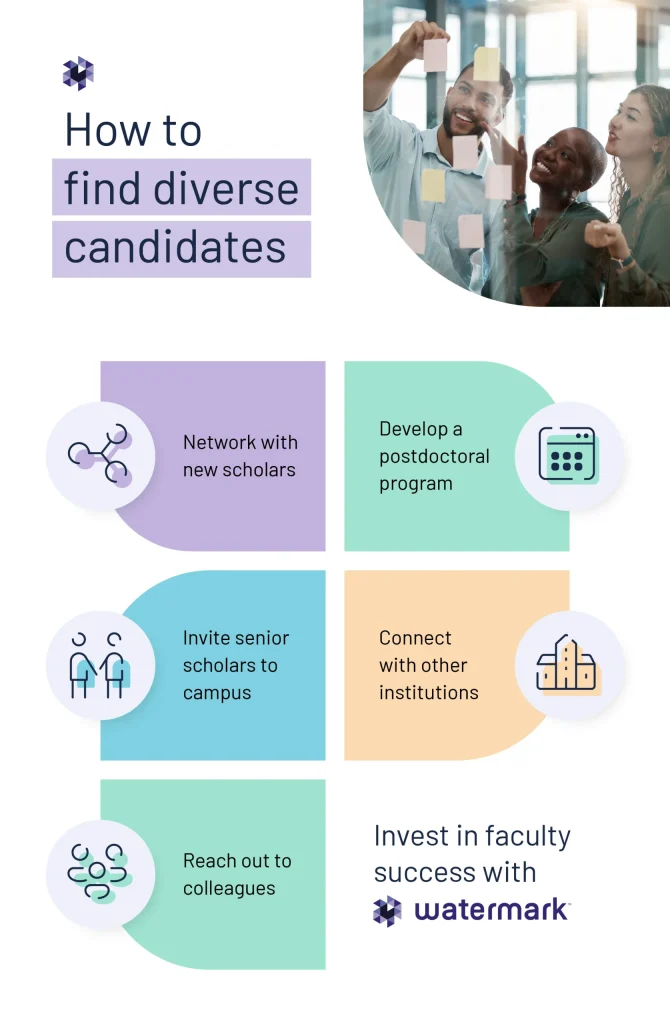



A diverse and inclusive faculty can greatly benefit your students and institution. Currently, nearly 75% of higher education faculty members are white, creating a significant diversity gap among faculty members.
With a diverse faculty, students can redefine what they believe a scholar looks like, become more engaged in classes, and feel more satisfied in their campus experience. Diverse students can see instructors and mentors reflecting their backgrounds and perspectives in established, recognized institutions and positions, effectively aiding their academic progress and increasing student retention.
Keep reading to discover the best practices in faculty development.
Recruiting instructors can take time, but filling your team with new perspectives and ideas can benefit your students and institution. Beyond interviewing candidates, you must utilize other best practices to ensure each team member you add will positively contribute to your institution. The best practices in faculty development will occur before, during, and after the faculty search committee process.
For successful minority teacher recruitment, you must dedicate strategic efforts before the search begins. You will need to develop a meaningful process flow and fill your team with exceptional members. Keep reading to discover the best practices to use before the search.
Your search committee will play one of the most vital roles in your search process. Ensure all committee members receive recruitment training so they know how to find the best candidates to support your institution.
Using the job description and understanding the role criteria you’re looking for, you and your committee should devise a plan to attract desired candidates. This plan should include a faculty hiring process timeline, so your committee can ensure each candidate receives the same opportunities and time to stand out during interviews and calls.
Craft your plan by working backward. Decide when you would like a new hire to begin or when you want to extend an offer letter. Include grading periods, holidays, and other times when effective recruiting may be difficult.
Before looking for potential candidates, your committee should establish a list of criteria for each candidate to meet. Without a preset of requirements, committee members may determine standards supporting their preferred applicant. Areas to explore include a candidate’s:
Although your goal may be recruiting teachers of color and other underrepresented groups at your campus, you also want to ensure you’re fulfilling each position with a worthwhile candidate who will positively impact student experiences and improve your institution. Keep the description broad enough to attract a diverse pool of applicants since narrowing the description may discourage highly qualified applicants.
Avoid describing a position as a replacement for a faculty member who has retired or left. Ensure you depict your institution as one that welcomes inclusivity and diversity, and be sure to outline your desire to find candidates who support these ideals.
After you’ve outlined the position description, created a list of candidate criteria, and filled your committee with knowledge and diverse members, your institution can begin searching for potential candidates. Here, you will utilize the best-in-class recruitment practices to find the top candidate for the open position.

You cannot expect to find many diverse candidates if you don’t create a diverse pool. Ensure you advertise the position and criteria broadly to ensure more candidates apply. You can also form a diverse candidate pool in a variety of ways, including:
Candidate evaluation will determine whether a potential hire moves along in your search process. Your committee must refer to the preset criteria they’ve established when evaluating a candidate. This way, you can reduce the amount of unconscious bias that may occur and ensure each candidate receives a fair assessment.
Subconscious cognitive bias occurs every day and impacts many large and small decisions we make. This process influences our actions, and your recruitment committee is no exception. The first step in overcoming bias is recognizing that everyone is susceptible to it. Once people understand bias, they can work to question their thoughts and use measurements rather than opinions to inform decisions.

You should educate your committee on bias and minimize the possibility of impact. Preset criteria will aid in this, but you can also craft tools to measure candidate strengths, weaknesses, attributes, and accomplishments rather than relying on committee members to evaluate these.
As your committee draws to a close on its timeline, they should establish the desired candidate and a few alternatives. Each candidate and alternative should fit the preset criteria and show the potential to impact your institution positively. At this point, the committee should present the candidate to the dean or chair to create an offer letter.
Your institutional efforts to become more diverse and inclusive do not stop once the candidate search is over. After attracting and hiring new team members, you must work to keep them. Hostile climates, a lack of recognition, and racialized promotion and tenure processes are among the top reasons diverse faculty members leave institutions.
After hiring a new faculty member, you must dedicate efforts to creating and promoting a welcoming and inclusive environment that satisfies every employee.
Once you’ve selected a candidate, you should conduct a debrief with the search committee, new hire, dean, and candidates who rejected your offer. Discuss what the committee could have done differently and ensure you note the advice and opinions of various candidates. This way, you can refine the search process and ensure it runs smoother during the following search process.
When your new hire arrives on campus, you should monitor their progress and whether they’re exhibiting the potential your committee identified. At this point, you should also determine what programs and organizations you can develop or improve to ensure faculty members can receive support and continue impacting your institution while delivering quality classroom experiences to students.

Watermark has been crafting higher education solutions for more than two decades. We designed our software solutions to deliver effective and meaningful data that support your faculty, students, and institutional goals. We’ve already helped higher education institutions become more diverse, and we want to help other colleges and universities achieve the same commitment to diversity and inclusivity.
Watermark Faculty Success showcases accomplishments and supports personal growth. With our software, you can create customizable reports, pull data from multiple sources, and transform data into action. You can create a holistic picture of your faculty and their needs to ensure you guide them to success while supporting your institution.
Request a Watermark Faculty Success demo and begin delivering the support your faculty needs to flourish.





























































































































































































































































































































































































